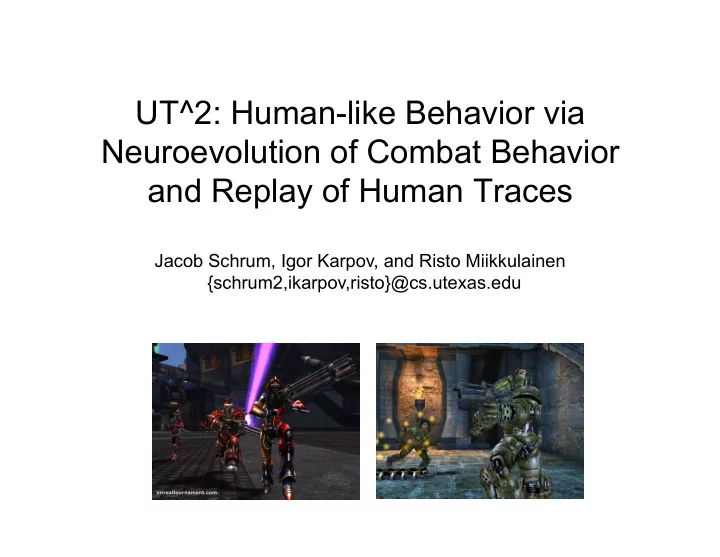

UT^2: Human-like Behavior via Neuroevolution of Combat Behavior and Replay of Human Traces Jacob Schrum, Igor Karpov, and Risto Miikkulainen {schrum2,ikarpov,risto}@cs.utexas.edu
Our Approach: UT^2 • Evolve skilled combat behavior – Restrictions/filters maintain humanness • Human traces to get unstuck and navigate – Filter data to get general-purpose traces – Future goal: generalize to new levels • Probabilistic judging based on experience – Also assume that humans judge well
Bot Architecture
Use of Human Traces
Record Human Games “Wild” ¡pose ¡data ¡ “Synthe(c” ¡pose ¡data ¡
Index and replay nearest traces • Index by navpoints – KD-tree of navpoints – KD-trees of points within Voronoi cells – find nearest navpoint – find nearest path • Playback – Estimate distance D – MoveAlong the path for about D • Two uses – Get unstuck – Explore levels
Getting unstuck has highest priority
Unstuck Controller • Mix scripted responses and human traces – Previous UT^2 used only human traces Stuck Condition Response Still Move Forward Collide With Wall Move Away Frequent Collisions Dodge Away Bump Agent Move Away Same Navpoint Human Traces Off Navpoint Grid Human Traces • Human traces also used after repeated failures
Traces used within RETRACE w/low priority
Prolonged Retracing • Explore the level like a human • Based on synthetic data – Lone human running around collecting items • Collisions allowed when using RETRACE – Humans often bump walls with no problem • If RETRACE fails – No trace available, or trace gets bot stuck – Fall through to PATH module (Nav graph)
Use of Evolution Evolved neural network in Battle Controller defines combat behavior
Constructive Neuroevolution • Genetic Algorithms + Neural Networks • Build structure incrementally (complexification) • Good at generating control policies • Three basic mutations (no crossover used) Perturb Weight Add Connection Add Node
Battle Controller Outputs • 6 movement outputs Item – Advance – Retreat Bot – Strafe left – Strafe right – Move to nearest item – Stand still • Additional output – Jump? Enemy
Battle Controller Inputs Pie slice sensors for enemies Ray traces for walls/level geometry Other misc. sensors for current weapon properties, nearby item properties, etc.
Battle Controller Inputs • Opponent movement sensors – Opponent performing movement action X? – Opponents modeled as moving like bot – Approximation used
Evolving Battle Controller • Used NSGA-II with 3 objectives – Damage dealt – Damage received (negative) – Geometry collisions (negative) • Evolved in DM-1on1-Albatross – Small level to encourage combat – One native bot opponent • High score favored in selection of final network • Final combat behavior highly constrained
Playing the judging game
Judging • When to judge – More likely after more interaction – More likely as time runs out – Judge if successful judgment witnessed • How to judge – Assume equal # humans and bots – Mostly judge probabilistically – Assume target is human if it judged correctly
Results
Judges ’ Comments • Bot-like – Too quick to fire initially after first sight – Ability to stay locked onto a target while dodging – Lots of jumping – Knowledge of levels (where to go) – Aggression with inferior weapons – Aim is too good most of the time – Crouching (Native bots)
Judges ’ Comments • Human-like – Spending time observing – Running past an enemy without taking a shot – Incredibly poor target tracking – Stopping movement to shoot – Tend to use the Judging Gun more
Insights • Judges expect opponents of similar skill – Our bot was too skilled – Humans are fallible – Would mimicry help? • Human judges like to observe – Playing the judging game – Plan to judge in advance – Expecting bots to be like judges
Previous Insights • Botprize 2008, 2009: No judging game – Judges set traps: follow me, camping, etc. • Botprize 2010: Judging game – Snap decisions were sometimes correct: how? – Still setting traps
What ’ s Going On? • Humans have always been more human – Why?! Botprize 2008 2/5 fooled • We ’ re not getting better Botprize 2009 1/5 fooled • Need better understanding Botprize 2010 31.82% humanness CEC 2011 30.00% humanness • Native bots are better! – Botprize 2010: 35.3982% humanness – CEC 2011:
Future Competitions • How does judging game complicate things? – Should human-like = judge-like • What is our goal? – Human-like players for games? • But the native bots are already better! – Bots that deliberate/observe/ponder? • But at the expense of playing skill
Questions? Jacob Schrum Igor Karpov Risto Miikkulainen {schrum2,ikarpov,risto}@cs.utexas.edu
Recommend
More recommend